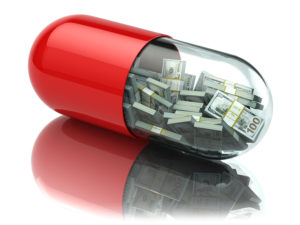By Chase Johanson, Executive Search Consultant, Gibson Consultants
Pharmaceutical Costs Continue To Climb
One of the most difficult challenges that hospitals and health systems all across the world face is managing their pharmaceutical spending. “Rising pharmaceutical costs present one of the most urgent and unsustainable. We continue to see aggressive and unwarranted price increases for drugs that are critical to care for patients and where substitutes are not available. For hospital supply chain leaders, this paradigm is not only pressing, it is unsustainable,” according to Scott Caldwell, President and CEO of The Resource Group.1
In speaking with hundreds of doctors, nurses, and supply chain professionals, one thing appears evident at every organization, even those that have carefully integrated pharmacy procurement into their supply chain. Pharmacy supply chain is its own specialty that deserves extra attention from health systems and should not be treated the same as traditional clinical and non-clinical supply chain.
Usually delegated to a team dedicated to pharmacy and pharmaceutical procurement, this supply chain vertical is under the spotlight more than ever during this COVID-19 pandemic. According to Modern Healthcare, “While many health systems have yet to experience any related drug shortages and many generic drug suppliers have 3 to 12 months of active pharmaceutical ingredients stocked, executives are increasingly concerned by the opaque system that is dependent on foreign countries.”2 There are a few domestic generic pharmaceutical endeavors working to alleviate growing concerns, but one of the largest interests regarding the U.S. supply chain, aside from its growing costs, is the source of pharmaceuticals.
“We have become too dependent on China for essential medications. We need to rebuild U.S. infrastructure for essential generic pharmaceuticals,” said Civica Rx CEO, Martin Van Trieste.3 It is important that the healthcare industry in America continues to innovate to strengthen the pharmacy supply chain and strive to deliver higher quality care and improve costs for our growing population.
Organizations On the Forefront
A few endeavors making their way into the headlines recently include government action like 403(b), and companies like Amazon, Pillpack, and Civica Rx entering the generic drug industry. Organizations like Civica Rx are hoping to provide generic pharmaceuticals at lower prices and help smaller hospitals and health systems that lack purchasing power. The race to deliver quality, generic pharmaceuticals to drive down cost and improve quality patient care is on.
Supply chain in healthcare is always best addressed case by case and every organization is different. There are many factors that go into making a decision when sourcing pharmaceuticals: The size of an organization, the GPOs they partner with, the emphasis the organization puts on supply chain, the number of agreements already in place, the area and demographic of its patients, etc. It is extremely difficult for any individual provider to understand the big picture without having the data and information to drive good business decisions. These innovative industry actions and organizations that focus in generic pharmaceuticals will work to help providers better strategically source pharmaceuticals and ensure a strong supply chain during times of crisis, like COVID-19.
Currently, there are directors of pharmacy in supply chain at most established IDNs (Integrated Delivery Networks). There is always conversation between the clinical and business side of healthcare in the form of value analysis committees or single value analysis professionals with an understanding of the clinical world acting as a soundboard for making educated decisions. The best practice in the industry is typically a mix between pharmacy professionals and value analysis professionals together tackling the pharmacy supply chain. There is a level of trust that pharmacists and clinicians must have for the supply chain process and personnel. Due to the complexity of the trade, most traditional supply chain directors in healthcare do not have experience in pharmacy supply chain and rely heavily on those that have a better understanding of the specialty. This is the reason that the pharmacy supply chain is kept under its own umbrella at hospitals and health systems.
Larger organizations have a clear advantage due to economies of scale and can negotiate better prices by using a spoke-and-hub approach to their many hospitals around the country. Smaller organizations are at a clear disadvantage because they do not have the leverage that major IDNs have. With rising costs, pharmaceutical spend is unsustainable for smaller hospitals and health systems.
A Pennsylvania health system, involved with Civica Rx, has a VP of Pharmacy and a VP of Supply Chain that report to the COO. They believe that the inventory needs of the general supply chain are different from the needs in pharmacy. Putting emphasis on pharmaceuticals and working with an organization dedicated to combatting rising costs is one way hospitals in America are successfully bringing their patients better quality care.
COVID-19
Pandemics can set healthcare organizations back many years financially. COVID-19 is a real-world example of how disease has affected, at the very least, the way we think about and approach the pharmacy and non-pharmacy supply chain. “The Indian government may hold 26 pharmaceutical ingredients and drugs made from them amid supply concerns stemming from the coronavirus, stretching an already fragile pharmaceutical supply chain,” says Modern Healthcare.2 “Much of the world’s supply of generic drugs comes from India, which relies heavily on China for their active pharmaceutical ingredients.”2 Many leaders in the industry believe that, moving forward, America should put more emphasis on sourcing domestically rather than depending on imports from China and India. America already faces drug shortages every year without import constraints. Although shortages can be quality issues from the manufacturer or from manufacturers that choose to make more profitable drugs, each year there are over 100 reported drug shortages, according to the American Society of Health System Pharmacists’ list, which jeopardize patient care and inflate healthcare costs.4,5 This does not take into consideration treatments for COVID-19.
The entire healthcare industry and especially providers must work to solve the problem of drug shortages, rising costs, and the lack of domestic production of pharmaceuticals. Although pharmacy is given extra attention at most organizations, there is a lot of work to be done to close the gap that is growing with the aging U.S. population. Supply chain professionals must work to leverage value analysis and pharmacy professionals to stay on top of trends and prepare for the worst. Hospitals and health systems will need support from group purchasing and consulting organizations aimed at diverting pharmaceutical sourcing away from other countries. Healthcare IDNs will have to come together to innovate and put more focus on generic pharmaceutical organizations if they want to overcome the issues facing America and deliver higher quality care at lower costs for patients.
References
- Scott Caldwell Addresses Top Supply Chain Issues. Feb. 2020. https://theresourcegroup.com/News/2020-Scott-Caldwell-Addresses-Top-Supply-Chain-Issues
- Coronavirus Strains Fragile Pharmaceutical Supply Chain. March 2020. https://www.modernhealthcare.com/supply-chain/coronavirus-strains-fragile-pharmaceutical-supply-chain
- Trieste, Martin Van. March 2020. https://www.linkedin.com/posts/mvantrieste_we-have-become-too-dependent-on-china-for-activity-6650104072969998336-DYRQ
- The Drug Shortage Crisis in the United States: Causes, Impact, and Management Strategies. C. Lee Ventola. PT. 2011 Nov; 36(11): 740-742, 749-757. PMCID: PMC3278171. https://www.ncbi.nlm.nih.gov/pmc/articles/PMC3278171/
- Drug Shortages Statistics. 2020. https://www.ashp.org/Drug-Shortages/Shortage-Resources/Drug-Shortages-Statistics






